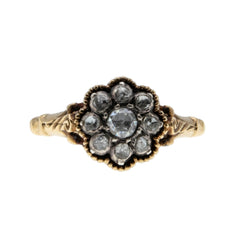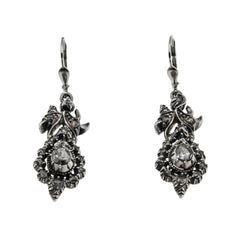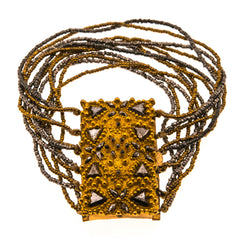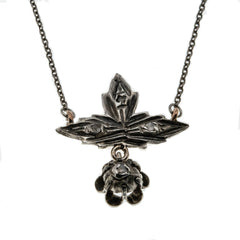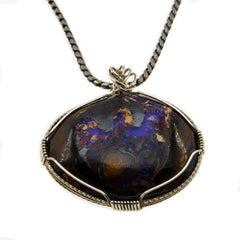Recently Sold (GR032)
Rarities Antique Jewelry
Sorry, this item is Sold
Bague Au Firmament - Georgian French 14K Gold & Sterling Silver Rose Cut Diamond Cobalt Blue Enamel 'Night Sky' Navette Ring. This exquisite ring is crafted from 14K gold, and sterling silver, tested. The ring features one natural oval rose cut diamond, 40 natural round rose cut diamonds, Georgian era detail, and high quality craftsmanship. This stunning ring is created in the form of a 'navette' or 'marquise' shape, which is inlayed by cobalt blue enamel (glass) , and adorned by glowing antique cut diamonds designed in a floral motif. The reverse side to the gallery is engraved by exquisite floral engravings. The shoulders of the ring exhibit a split-design, which is beautifully carved midway, and leads down to a smooth and polished shank. This allows for a comfortable fit, and easy sizing. This precious rare Georgian era ring would make an amazing addition to any fine antique jewelry collection.
Note: Contemporary appraisals do not reflect the value of antique jewelry. It is recommended that this Victorian era ring be insured for $10,000.00 (Tax Excluded)
History: A 'Bague Au Firmament' (French for "ring of the heavens) is a type of ring that was popular in the 18th and early 19th Centuries, particularly during the Georgian period. These rings are known for their celestial -inspired design, featuring a blue ground (often blue glass or enamel) representing the sky, with diamonds to evoke stars. These rings are getting increasily rare.
The earliest diamonds were found in India in 4th century BC, although the youngest of these deposits were formed 900 million years ago. A majority of these early stones were transported along the network of trade routes that connected India and China, commonly known as the Silk Road.
The rose cut originated in the 1500's and was commonly used through the Georgian and Victorian eras. Like other antique diamond cuts, they were cut by hand and meant to dazzle under candlelight. Their large, wide facets performed exquisitely in low light conditions.
The rose cut is considered to be one of the oldest diamond cuts. Rose cut diamonds gathered popularity from their creation in the 1500s right through to the late 19th Century.
Today, they are seeing a renaissance and are highly sought-after.It can be challenging to find a rose cut that you'll love because they are so rare in the market. - Because the rose cut diamond is cut by hand, there will often be tiny imperfections or asymmetries to the facets.
Many are already aware of history behind the 'ring finger,' and with the romanticism of the 'Rose Cut', the cut became a symbol for love as the ring would be “wrapped around the part of the body that connected directly to the heart”
You cannot look at rose cut diamond jewelry factually with a recut formula in mind, its value is object driven. Rose cuts are a greater challenge in estimating weight once they have been mounted (especially if they are closed back). These rose cut diamonds are hand cut, which makes them so special . This is a rare find.
Gold was generally used for a couple thousand years solely to create things such as jewelry and idols for worship. This was until around 1500 BC when the ancient empire of Egypt, which benefited greatly from its gold-bearing region, Nubia, made gold the first official medium of exchange for international trade.
Silver Mining in History. The story of silver mining began about 5,000 years ago. Silver was first mined around 3,000 BCE in Anatolia, now located in modern-day Turkey. The precious metal helped early civilizations in the Near East, Ancient Greece to flourish.
The term "sterling silver" probably originated in eastern Germany when five towns formed the Hanseatic League in the 1100s. These town minted their own coins of 92.5 percent silver. When Britain sold cattle and grain to the League, they were paid in "Easterling coins".
In English, "navette" is a noun, primarily used in the context of jewelry to describe a marquise-shaped marquise-shaped gemstone or jewelry contour.
Diamond cutters will refer to the marquise-cut with other names as well, such as a "Navette" shape (meaning "little boat" or "little ship" in French) as the shape appears to resemble the hull of a small ship.
The marquise-cut diamond's or shape in history is linked to 18th century France, specifically the reign of King Louis XV. He commissioned a jeweler to create a diamond cut resembling the lips of his mistress, Madame du Pompadour, a woman of renown for her beauty. This unique shape, characterized by an elongated, oval outline with pointed ends, became known as the "marquise" cut.
The Georgian era was a period in British history from 1714 to c. 1830–1837, named after the Hanoverian kings George I, George II, George III and George IV. The definition of the Georgian era is also often extended to include the relatively short reign of William IV, which ended with his death in 1837.
Measurements: Face of the Ring 26.00 mm x 14.00 mm
Stone Size: Diamond (Rose Cut) .65 carats Clarity SI1 Colour G
Weight: 4.95 grams
Ring Size: 8
Condition: Excellent Note: Never clean any early jewelry (those with closed backs) with water or any other liquid. Use only the softest toothbrush to very gently brush away dust or old dirt. You may also use a very soft, lint-free cloth to clean the surface of stones and gold and silver.
Origin: France
Date: Circa 1820















